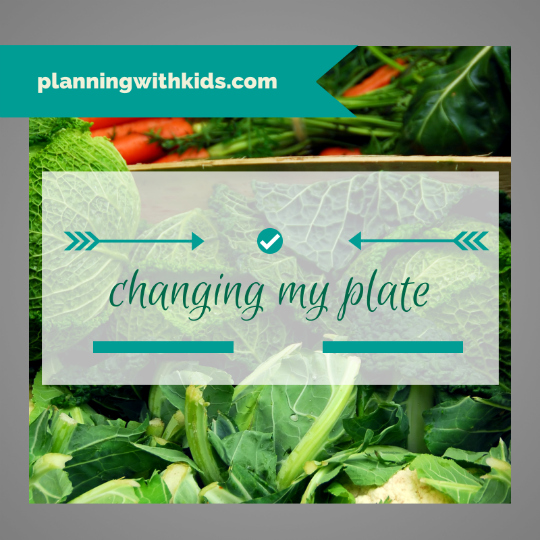This post is part of a regular series focusing on making small changes to improve our health. I shared my journey with changing my diet and moving to a clean eating approach which you can read here. I also had the lovely Katie Rainbird from Katie 180 undertake an analysis of my food intake for one day in that post, which was another step in the right direction.
Together we also offered the same opportunity to readers of Planning With Kids. We were blown away with the response and while I can’t guarantee will get to all of them this year, Katie has been busy working on many of the submissions already and we will publish as many as we can.
It is not possible for Katie to cover off everything in these posts. The aim is for her to find some small things you can change to what you are putting on your plate to help you achieve your current goal for your eating habits. You can read previous Changing my plate posts by clicking here.
Changing my plate – Trish’s day
 Katie Rainbird (AKA Katie180) is a Sydney-based Nutritionist who is just as likely to be found jogging as she is baking. She is a mother to two, a keen home cook, prefers to get around in her workout gear and has a major passion for the written word. You can learn more at www.katie180.com.au.
Katie Rainbird (AKA Katie180) is a Sydney-based Nutritionist who is just as likely to be found jogging as she is baking. She is a mother to two, a keen home cook, prefers to get around in her workout gear and has a major passion for the written word. You can learn more at www.katie180.com.au.
Katie reviewed what a reader Trish (not real name as readers wished to be anonymous) submitted that she ate in a 24 hour period. This is what Katie had to say about her day:
What is your current goal with your eating habits?
I am trying to lose weight, reduce my intake of processed high sugar foods and generally eat a healthy diet although chocolate is my weakness……
Breakfast
0600 at work I had 1 cup of 5 grain and fruit natural muesli with 1/2 cup of milk
Buy a portable soup mug and each night add in: 1/2 cup whole rolled oats, 1 teaspoon chia seeds, 1/4 cup mixed sunflower and pumpkin seeds and then a scattering of dried fruit of choice then cover with almond milk and leave overnight. Before leaving for work or when you get to work, add a dollop of yoghurt or some additional milk (can be dairy) and a drizzle of honey or vanilla extract or maybe some cinnamon to sweeten. MUCH better than store bought muesli: you control what goes into it, everything is soaked making it easier to digest and it’s very filling.
Lunch
Store brought soy and linseed toast (two pieces) with table spoon of peanut butter
1 apple
1 bottle of low fat strawberry yoghurt
I am able to make my lunch at home
Switch to a full fat or Greek style yoghurt without any sweetener and sweeten yourself with poached fruits, honey or maple syrup. This meal would actually be better off as your breakfast! If you can make lunch at home then go for poached chicken breast shredded with free range mayonnaise, celery, shaved fennel and some slivered almonds, served with cooked whole grains or onto some sourdough bread with lots of leafy greens or some thinly sliced cucumber. When approaching your meals think: protein (either animal or plant such as legumes, beans, seeds, nuts) and fresh produce with whole grains and their products featuring as the lesser portion of the meal.
Dinner
6pm
1/2 cup mashed potato with butter
3 broccoli florets
3/4 cup of peas/beans/carrots
1 lamb chop
1/4 cup packet gravy
I can’t get on board packet gravy! Try reducing a little vegetable stock in a pan then adding some wholegrain or Dijon mustard and a lick of cream. Or just mix together some store bought pesto and cream (or omit the cream if you prefer) and use this to accompany meat instead.
Snack 1
mid morning approx 15 mixed natural nuts (cashews, walnuts, almonds, hazelnuts, macadamias) and 20 grapes
Perhaps opt for a fruit with a higher fibre content that is also a little less immediately sweet, such as a banana or pear.
Snack 2
mid afternoon 6 wholegrain rice crackers with hummus (store brought)
Swap rice crackers to rice cakes. You can buy the large rice cakes and have just two where you’d usually have rice crackers. Choose a humus that is as minimally processed as possible.
Snack 3
Snack 4
Dessert
No dessert but this is where I sometimes 1-2 times a week have chocolate.
I’m totally OK with “sometimes” chocolate. Enjoy.
Nutritional supplements
Nil
Daily fluid intake
800mls water
3 cups instant coffee with milk (I used to have sugar)
1 cup Milo with milk
Try to reduce to two coffees and also try to eliminate the Milo or replace with sugar free cocoa and sweeten with honey or maple syrup. You could opt for an almond milk here rather than cow’s milk to reduce your intake of dairy and switch things up a bit.
Any further information you’d like to share or special dietary requirements to factor in?
I currently take Venaflaxine and Olanzapine, one of the side effects of the Olanzapine is increased hunger and I have gained 8.5 kilos in 6 months which doesn’t sit well with me. I have seen a dietician who has given me a reduced calorie diet plan but this restricts veggies to 2 serves and fruit to 1.5 serves which i don’t feel is enough would be keen to hear your thoughts
Low calorie diets are not guaranteed to work! What we know now about low calorie (often low fat) and weight loss has all turned on its head (thankfully) and nourishing saturated fats from grass fed cattle, free range poultry, wild seafood, butter, ghee, coconut oil, cold pressed nut and seed oils, eggs, nuts and seeds are returning to centre stage as food that ought to be included more readily and certainly in place of their “low fat” imitations. Particularly with medications that induce weight gain, option for a higher dietary intake of such foods ought be an “easier” way of it than limiting fruits and vegetables (which I don’t agree with). Also, as these foods provide fatty acid backbones and amino acids for the biological manufacture of hormones and neurotransmitters (serotonin is a neurotransmitter) then increasing them as part of your approach to managing mental health may very well be a good idea.
Katie’s Summary
Emphasis is on replacing store bought options such as cereal and sauces with home made options, reducing caffeine intake and increasing fresh produce and protein.
Further reading and recipes
- Fennel Slaw with Coriander and Continental Parsley
- Top5 ways to eat a takeaway BBQ chook
- Ghee – what is it and its health benefits.
- Top 5 ~ Chia Seeds
Disclaimer
Katie is a qualified nutritionist (Adv. Dip. Nutr. Med.).
Any diet or lifestyle changes that you implement as a result of reading this blog are your own responsibility.
This blog does not provide medical advice, any particular health conditions must be managed by your own health professional.
The content of this blog is not intended to be a substitute for professional medical advice, diagnosis or treatment.
Always seek the advice of your physician or other qualified health provider with any questions you may have regarding a medical condition. Never disregard professional medical advice or delay in seeking it because of something you have read on this blog.

